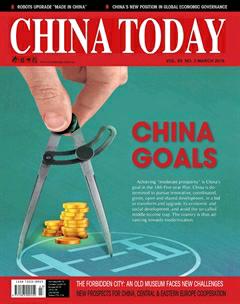Economy
Economy
China Expands Cross-border E-commerce Pilot Zones to 12 Cities
China plans to set up 12 more pilot zones for cross-border e-commerce, according to a statement released by the State Council in January. The 12 cities are Tianjin, Shanghai, Chongqing, Hefei, Zhengzhou, Guangzhou, Chengdu, Dalian, Ningbo, Qingdao, Shenzhen, and Suzhou. Their establishment will provide new support to boost the country’s foreign trade.

The move follows the 2015 opening of a pilot zone in Hangzhou, where e-commerce giant Alibaba is headquartered. The statement mandates that new pilot zones shall emulate the Hangzhou model, but allows them to adapt development measures to local conditions.
By experimenting in the areas of technical standards, business procedures, regulatory mechanisms and informatization development, the new zones aim to provide transferable experience to businesses nationwide. The zones will attract businesses, help create jobs, and nurture new business models to boost foreign trade and stimulate the economy, the State Council has announced.
Expansion of the pilot zones comes even as the nation grapples with sluggish foreign trade. Total export and import values for 2015 decreased seven percent year on year to RMB 24.59 trillion, falling for the first time since 2009.
The Ministry of Commerce has predicted that the trade volume of cross-border ecommerce in 2016 will reach RMB 6.5 trillion, and that figure is expected to hit RMB 8 trillion in 2017, accounting for 20 percent of China’s foreign trade within the next few years.
Global Top 500 Firms Invest Actively in China
The world’s top 500 firms increased investment in China last year, manifesting unflagging confidence in the economic outlook of the world’s second largest economy, according to China’s Ministry of Commerce.
Multinational corporations including Audi, Fiat, Samsung, ITOCHU, and Intel, all increased their investment in China in 2015, each funneling more than US $100 million, according to ministry data.
The number of regional headquarters and research institutes founded by these corporations also continued its rise last year. At present, international companies have endowed more than 2,400 research institutes in China.
Statistics indicate that, in the January-November period last year, the number of newly-registered foreign-invested enterprises hit 6,040 in pilot free trade zones in Guangdong, Tianjin and Fujian, attracting RMB 445.8 billion in contracted foreign investment.
The introduction of the negative list system has helped entice foreign investors, per the ministry, whose statistics demonstrate that the actual use of foreign capital (which excludes data of the financial sector) rose 6.4 percent year on year to US $126.27 billion in 2015.

Chinese Companies Stoke Outbound Spending on Property
According to a recent Xinhua News Agency report, as domestic property markets chill, Chinese investors are spree-buying overseas assets in a bid to increase both profit and presence in the global arena.
“Last year was tremendously busy. In December alone, I closed 750 million sterling in deals in the U.K.,” said Chris Harvey, a lawyer with global law firm Mayer Brown, and an adept in London real estate investment. Harvey’s clients are in the main Chinese investors.
A report from leading global real estate firm Savills states that purchases of overseas assets by Chinese buyers will likely surpass US $20 billion for all of 2015, a jump from US $14 billion registered in 2014.
In 2015, China’s Anbang Insurance completed acquisition of America’s most famous hotel dynasty, the Waldorf Astoria New York, at a cost of US $1.95 billion. China Investment Corporation spent over US $1.7 billion to net Investa’s Australia office portfolio. The Taiping Life Insurance splurged US $820 million on a real estate project at 111 Murray Street in New York. Global real estate services and investment firm CBRE estimates that Chinese investors acquired a total of US $8.6 billion of commercial real estate in the U.S. in 2015 alone. This excludes real estate development, where Chinese firms are also taking huge stakes.
China’s outbound investment is expected to continue to boom in 2016.

Chinese Per Capita Disposable Income Rises 7.4 percent in 2015
China’s national per capita disposable income stood at RMB 21,966 (about US $3,350) in 2015, up 7.4 percent from 2014 in real terms, outpacing GDP growth at 6.9 percent for the same period, as official data revealed at the end of January, 2016. Urban and rural residents both derive their income mainly from work. If a nation’s income distribution system allows its labor income to draw a larger share of income distribution, its people’s income growth can outpace its GDP growth. China has gradually adjusted its income distribution system over the past few years, with policy makers focusing more on people’s livelihoods, thus enabling more to reap the benefits of national economic development. The government has improved social security as well, and granted subsidies to low-income families, thus averting a further widening of the gap between rich and poor. In addition, more specific legal rules have been issued to guarantee workers receive all payment earned. Thanks to the government’s efforts, growth in disposable income has still outpaced GDP growth over the past two years.
Separately, urban per capita disposable income and rural per capita net income reached RMB 31,195 and RMB 11,422 respectively in 2015, up 6.6 percent and 7.5 percent in real terms, according to the National Bureau of Statistics (NBS).
China’s Gini coefficient, an index reflecting the rich-poor gap in which zero equals perfect equality, stood at 0.462 in 2015, dropping for seven years in a row, after the index had hit 0.491 in 2008, NBS data showed.
The average monthly wage of rural migrant workers, whose population reached 277.5 million in 2015, was RMB 3,072, an increase of 7.2 percent over the previous year.
The Chinese government aims to double the 2010 per capita income of urban and rural residents alike by 2020 to build what it terms a “moderately prosperous society.”

